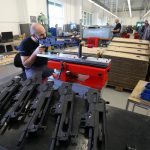Croatia’s property market has to be seen as a regionally indispensable part of economic development.
As Ana Blaskovic/Poslovni Dnevnik writes on the 5th of October, 218, big cities are currently the main focus of property market players, only then do all others follow, but at the region level, this market has exceptional potential as an indispensable part of Croatia’s economic development. That topic was devled into at Njuškalo’s New Link conference, which was held in Zagreb on Wednesday.
“We’re an open book on which other sectors such as tourism, and ultimately the retirement of people in Croatia, lean on,” said Robert Pokrovac, of Erste. In Dalmatia, which has been recording record tourist seasons, the tourist season’s extension has a direct impact on the property market. Tourism has conquered big cities, the properties are there, but there’s no additional content.
Real estate professionals see the main potential in retirees originally from Northern Europe being attracted to a milder climate. Although Istria’s good practice of old stone house renovation which has delighted foreigners could be mapped throughout Croatia, that region still has room for growth, for example in the construction of things like golf courses.
Lika, on the other hand, has only begun to feel the first signs of ”awakening” thanks to the tourists who are attracted by the natural beauty of its numerous national and other nature parks. Although housing is lacking in larger areas such as in Otočac, there is the lack of a healthy economy for the proper development of a property market, which is why investments in that part of Croatia are necessary.
Perception is much stronger than reality, and this undisputed truth should be used when branding some neighborhoods in cities, said Damjan Geber of the Brigade Agency.
Looking at the jump in prices and the increased demand for apartments and homes in neighbourhoods such as East Harlem or Williamsburg, in New York, which have been transformed from actual ghettos to areas with very high prices in the last twenty years, Geber believes that such smart and consistent planning could also happen in major cities across Croatia.
The design district around Martićeva street in Zagreb is the only attempt at such a thing at this time, and whether Trnje will be branded as an artistic quarter or Trešnjevka as a startup neighbourhood depends on the local community, but also on the understanding of the respective local authorities.
With Zagreb mayor Milan Bandić’s infamous ”fetish” for building fountains coming very much before anything else at all, the City of Zagreb failed to recognise the actual problems faced by the residents of the city’s neighbourhoods such as Trnje. Such similar moves being carried out in reality will depend very much on whether young people decide to stay in Croatia or move to cities that already recognise the need for such moves, such as Kreutzberg in Berlin, or Peckham in London.
Just like the famous slogan from the hit British comedy Only Fools and Horses – “New York, Paris, Peckham” in just one year, the formerly deprived Peckham became a creative hub.
Click here for the original article by Ana Blaskovic for Poslovni Dnevnik








